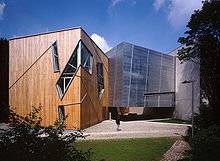- Felix Nussbaum Haus
-
The Felix Nussbaum Haus is a museum in Osnabrück, Germany, which houses the paintings of German-Jewish painter Felix Nussbaum. The building also houses an exhibition space, which focuses on racism and intolerance.
Contents
Origins
In 1991, the city of Osnabrück, Germany, decided to dedicate a museum to one of its natives, Felix Nussbaum, a Jewish painter who died in the Holocaust. In 1996, Daniel Libeskind's proposal, titled "Museum Without Exit," won the competition to design the building, which was completed in 1998.[1][2]
Design
The museum consists of three intersecting "volumes." The oak volume houses Nussbaum's prewar art. The second volume, which slices violently through the first, is made from concrete and contains the paintings Nussbaum made while in hiding from the Nazis. Dubbed "Nussbaum Gang," it evokes the cramped quarters in Brussels where Nussbaum painted his last canvasses. The metal volume displays the artist's newly-discovered paintings.[3] The interior is labyrinthine and many paths lead to dead ends.[4] The museum's sides face three cities where Nussbaum studied art: Berlin, Rome, and Hamburg. The fourth side faces the concentration camp where he was killed. The galleries house approximately 160 of Nussbaum's paintings.
Reaction
According to The Times, the museum, whose "narrow tunnel and subdued lighting impose an atmosphere of oppression,""clearly uses the idiom of displacement, loss and incomprehension."[5] Jonathan Glancey, in The Guardian, calls it "a masterpiece...in architectural dialogue with the paintings hung on its walls." Detractors, however, have said that Nussbaum's work is powerful enough on its own that it would have benefitted from being exhibited in a more neutral space.[6]
References
- ^ Worsley, Giles (July 22, 1998). "The museum of no way out". The Daily Telegraph. pp. 20.
- ^ Riding, Alan (August 12, 1998). "Reviled in Life, Embraced in Death: A German Museum Honors an Artist Lost to the Holocaust". New York Times. pp. Arts First Page, E3.
- ^ Libeskind, Daniel (2004). Breaking Ground. New York: Riverhead Books. pp. 119, 199, 217. ISBN 1-57322-292-5.
- ^ Pearman, Hugh (July 27-August 1, 1998). "Walls hold back the forgetting". Zeitgeist. pp. 26–27.
- ^ The Times (July 29, 1998). "In Memory of Pain". The Times. pp. 33.
- ^ Glancey, Jonathan (July 27, 1998). "Right side of the wall". The Guardian. pp. 10.
External links
Categories:- Art museums and galleries in Germany
- Daniel Libeskind buildings
- Museums in Lower Saxony
Wikimedia Foundation. 2010.

